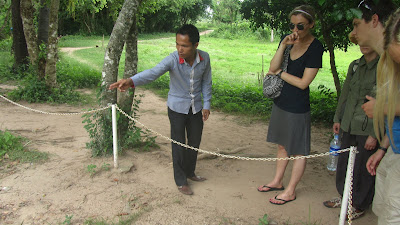




Monday June 20th
We were off early this morning for a twenty minute drive to the Tuol Sleng Genocide Museum. This museum commemorates the millions of Campochian citizens who were massacred by Pol Pot and the Khmer Rouge. Again we had a local guide to give us insight into the era (he's the one pointing in the bottom photo). He told us to call him Lucky, because he was the sole survivor of his parents children, because he was born two years after the Khmer Rouge were defeated. He lost two grandparents and three siblings during the genocide, but his parents survived. Pol Pot was a ruthless dictator who wanted to change the society from the monarchy led government to a communist one fashioned after the ideals of Karl Marx and Lenin. I forget his real name, but he gave himself the name Pol Pot, short for Political Potential. He called the country the Democratic Campochia and tried to remodel the society to his vision of communism. Everyone had to be a peasant and work on communal farms. There was to be no upper class or wealth, everyone would be equal. We emptied the cities and ruthlessly rounded up intellectuals, educated people, famous people (including nineteen members of the royal family, he spared the king because the people loved him, but he forced him to abducate) and put them into prisons, to be interrogated, tortured and executed. When a person confessed to being an intellectual his whole family was usually executed with him, because he believed that the children and wife were affected by the education and ideals of the father.
We visited the Tuol Sleng Genocide Museum, which was one of hundreds of prisons around the country. It was originally a high school, but Pol Pot closed the schools and converted this one to a prison. It was a bleak place that has not changed much in the last thirty years since the Vietnamese defeated the Khmer Rouge in 1979. In the rooms were hundreds of mugs shots of the people who were imprisoned here (the Khmer Rouge documented and photographed each prisoner at their arrest and at their death). The school rooms had been converted to torture chambers and divided into small cells where the prisoners were shackled in primitive conditions with little food, and no sanitation. Lucky told us in great gory detail about the conditions here and what the prisoners were subjected to. The whole regime was based on snitches who would tell on other people to save their own lives. Children were separated from their parents and brainwashed into not trusting their parents and spying on them in the fields, to see if they were 'stealing' anything to eat (that could be rice, or bugs or spiders or whatever). If a prisoner tried to escape or kill himself, the prisoner would be executed as well as the guard who was supposed to watch him. Prisoners here either died of torture or starvation or were executed. Small children were killed by throwing them off the roof of the prison.
From the museum we took another bus ride to the Choeung Ek Genocidal Centre. This is a monument to honour the thousands of people who died here in one of the infamous 'Killing Fields'. There were hundreds around the country and each housed dozens of mass burial grounds. There is a tower monument (in the photo) at the centre of the site that has 17 floors of human skulls that have been dug up and housed here. It was difficult to kill large numbers of people in the prison because of the proximity of the city, so the prisoners from the prison were brought here to the country to be executed where it was easier to do it in secrecy. They even hung up loudspeakers and played music to mask the sounds of the torture and killings. We walked past numerous depressions in the earth where people had been dug up, and areas where we could see bones, clothing and teeth poking through the soil as the rains have exposed them over the years. It was eerie standing on ground where you knew thousands of people had been murdered and buried. I learned a lot more, but I will save it for now and hope to do some further reading when I get home.
Then we boarded the bus for the return drive to Phnom Penh for lunch. Today we ate at a French restaurant that trains street kids to be waiters, cooks to provide them with a means to support themselves. This is another project that GAP supports. The food was delicious, although I got my curried chicken with mango and cashews first, then my bowl of pumpkin soup and finally the steamed rice. Oh well, still learning.
The rest of the afternoon I spent wandering around town. Met the group in the lobby and we took tuks tuks back to the river for dinner. We ate at a local restaurant that takes care of a number of orphans, raises them and trains them in their restaurant. Another worthy cause. Richard and I left the group as they decided what to do for the evening and we wandered back to the hotel on foot, to call it an early night.
A very nasty business indeed!
ReplyDeleteThe human race is still very capable of such atrocities. It always stirs up that contoversy, when do we intervene (or not) in another country's internal affairs? The cost is always high, but it seems it is always tragic when we don't intervene.
Extremely interesting and very scary. It is unbelievable how brutal man is
ReplyDeleteto man, and how it continues through history.